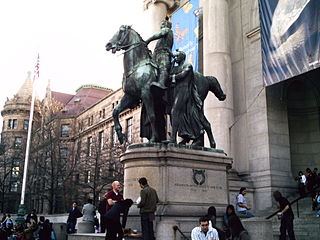
Ross Sandler, Center for New York City Law Director
The American Museum of Natural History gave the City a contemporary lesson in common sense in the manner that it has handled objections to the Roosevelt Memorial sculpture. The museum created a teaching moment in the best tradition of its educational mission.
The sculpture in front of the Museum at Central Park West and 79th Street depicts Theodore Roosevelt sitting majestically on a horse being led by two male figures on foot, a robed American Indian on Roosevelt’s right and a mostly naked African man on Roosevelt’s left. The sculptor declared that the figures symbolized North America and Africa, both continents associated with Roosevelt.
Contemporary views of the sculpture see racism and denigration of both American Indians and Africans, resulting in demands to remove the sculpture. Instead the Museum created an exhibition around the controversy which illuminates the issue without denying the past. The Museum’s statement states that:
“The statue was meant to celebrate Theodore Roosevelt (1858-1919) as a devoted naturalist and author of works on natural history. Roosevelt’s father was one of the Museum’s founders, and the Museum is proud of its historic association with the Roosevelt family.

The Roosevelt Memorial Sculpture outside the American Museum of Natural History. Image Credit: Wikimedia Commons/MacLachlan
At the same time, the statue itself communicates a racial hierarchy that the Museum and members of the public have long found disturbing. What is the meaning of this statue? And how should we view this historic sculpture today?”
The exhibition answers those questions through the voice of dozens of viewers, both public figures and ordinary visitors. The effect is to stimulate a more profound understanding of the past, and a more tolerant perception of contemporary feelings. The exhibit accords perfectly with the Museum’s mission to interpret and share knowledge of human cultures, and speaks powerfully on how to react to contemporary questions about the past.
Ross Sandler (Director of the Center for New York City Law and Professor at New York Law School)


When will they be unveiling the Sims monument at Greenwood?